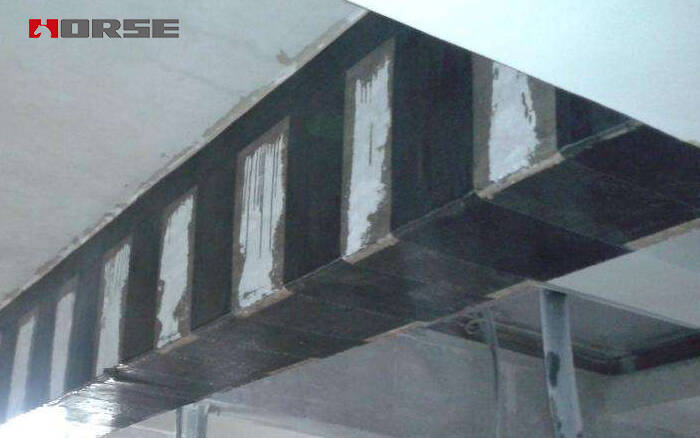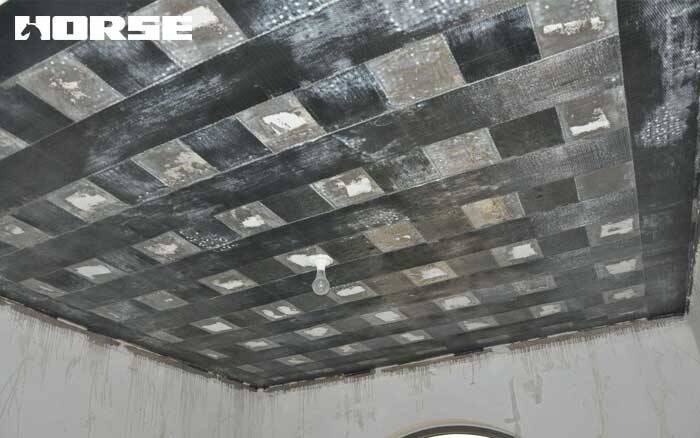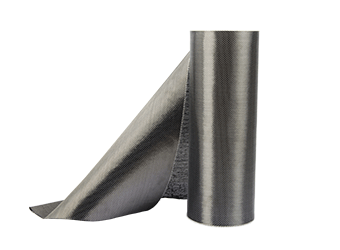Solutions
Horse Construction offers full range of structural strengthening materials with technical supports, documentation supports, products supports, project supports.
Application of carbon fiber strengthening beam and slab structure

Common problems of beam-slab bearing structure
The main reason for insufficient bearing capacity of beams, slabs and other flexural members in design is the inconsistent calculation of the force, or the calculation of load surge or miscalculation. Severe overloading may also lead to insufficient bearing capacity of beams and slabs, due to insufficient concrete strength during the construction process, or insufficient bending resistance of beams and slabs due to improper strengthening. In addition, the settlement of the foundation caused some additional stress due to other reasons, and some inappropriate devices were used to deal with this stress, which adversely affected the beams and plates. For example, when a thin web beam is added to the beam plate when dealing with stress, although the effect of stress can be balanced, the self-weight is also increased. However, oblique cracks may appear in some thin-web beams, resulting in corrosion of the beam and plate components, and the durability is greatly affected. In severe cases, the beams and slabs may break and affect the bearing capacity of the beams and slabs. Some of the reasons for the above situation are insufficient anchorage lap length or the influence of load changes. The main purpose of beam and slab load-bearing strengthening is to strengthen the strength, stability, rigidity and durability of the members.
Beam and slab structure strengthening
There is a big difference in the force-bearing performance of the beam-slab structure that has been built and strengthened and the general structural beam-slab without strengthening. One is that the reinforced structure is equivalent to secondary treatment and secondary stress. The structure needs to be subjected to secondary stress on the basis of the original stress, and the original structure may be deformed and bent. In addition, the original load is not removed during strengthening, which is equivalent to secondary compression. There is a difference between the newly added part of the stress and the load stress of the original structure. When the two stresses reach the peak value at the same time, the destructive force also reaches the limit state. Therefore, the above main problems are faced when strengthening the beam and slab. In addition, the overall work of strengthening the new and old parts is different, and there are big differences in the calculation of stress and structural treatment. Therefore, beam and slab strengthening is different from ordinary concrete structural engineering. Therefore, carbon fiber strengthening technology should be introduced in the strengthening to improve the strengthening of concrete beams and slabs.

The scope of application of carbon fiber strengthening
It is suitable for the strengthening and repair of various structural types and various structural parts, such as beams, slabs, columns, roof trusses, piers, bridges, cylinders, shells and other structures. The strength grade of the base concrete is not lower than C15, and the carbon fiber cloth strengthening technology has been successfully applied to various beam and slab strengthening and maintenance in China.
Carbon fiber strengthening project
In 2014, after Haimen Daxin Bridge tried to use glued steel plates to reinforce the bridge, Haimen Linjiang Gate Bridge was repaired for the first time to use the method of sticking and wrapping carbon fiber cloth to strengthen the bridge. Carbon fiber strengthening can quickly reinforce the bridge, prevent external moisture from entering the concrete cracks and rust the steel bars, and ensure the durability of the components. It helps to improve the bearing capacity of the bridge, and does not affect the normal operation of the bridge during the strengthening period. The Linjiang sluice bridge invested 350,000, and the highway department carried out a comprehensive repair of the existing diseases of the Linjiang sluice bridge, adding 4000kg of expansion joints to tie steel bars, and pasting 500 meters of carbon fiber cloth to the arch toe of the bridge. All kinds of hidden safety hazards were eliminated in time, which effectively improved the technical condition of trunk roads and bridges in Haimen, and effectively guaranteed the safety and smooth flow of trunk roads.
Carbon fiber strengthening features
Carbon fiber strengthening is the use of carbon fiber cloth and structural adhesive to reinforce the components. The strengthening damage morphology and the carbon fiber sheet strengthening form are as follows:
(1) The tensile steel bar yields, and then the concrete is crushed under compression, and the carbon fiber sheet has not yet reached the allowable tensile stress change requirement;
(2) The stress of the steel bar has reached yield, the carbon fiber has exceeded the allowable tensile strain, and has not exceeded the required strain value of the construction project, and the tensile has reached the ultimate tensile stress, and the concrete in the compression zone has not been crushed;
(3) The strengthening of carbon fiber cloth is too large, the steel bar yields, and the concrete in the compression zone is crushed;
(4) In the normal part of the bearing capacity, the carbon fiber cloth and the concrete foundation surface will peel off.
You can find anything here you are in need of, have a trust trying on these products, you will find the big difference after that.

High strength, unidirectional carbon fiber wrap pre-saturated to form a carbon fiber reinforced polymer (CFRP) wrap used to strengthen structural concrete elements.

High strength carbon fiber reinforced polymer (CFRP) strip / laminate / plate for structural strengthening and concrete repair

High strength, unidirectional carbon fiber fabric pre-saturated to form a carbon fiber reinforced polymer (CFRP) fabric used to strengthen structural concrete elements.